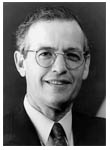|
April 18, 2001: President's Page
Some of the most ambitious undergraduate curricular initiatives in engineering during the past decade are intended to increase the engagement of liberal arts undergraduates. As dean of the school, James Wei says, they aim to offer these students new tools to help them express their creativity. New courses introduce A.B. students to the basics of engineering and provide them with technological capabilities and computer savvy. For example, this spring Professors of Electrical Engineering Margaret Martonosi and Stephen Lyon are team-teaching "Computing for a Mobile World" which covers the fundamentals of programming and computer systems using the specific example of handheld computers, such as palm pilots, to illustrate general concepts of computing. Students in Professor Vincent Poor's course on "The Wireless Revolution" develop a solid understanding of the technology of wireless telecommunication while exploring the regulatory, financial, and social issues that this rapidly developing field presents. While only in its second year, the course has attracted 180 students. Professor of Civil and Environmental Engineering David Billington has created several courses focused on structures with liberal arts students very much in mind. Professor Ferry Cook in Computer Science is offering a course this term co-listed with music. "Transforming Reality by Computer" provides students with a basic foundation in signal processing theory and techniques most useful for composing computer music. The course emphasizes the student's own creative use of aural material, and the interaction between the artistic and scientific aspects of the endeavor. Joint academic initiatives between members of the school and other departments are becoming increasingly frequent and productive. The SEAS encourages its students to take advantage of the growing and vital interface between engineering science and the life sciences, the earth sciences, physics and architecture. The Center for Photonics and Optoelectronic Materials (POEM), founded in 1988, and the Princeton Materials Institute, founded in 1990, both have as part of their central mission facilitating interdisciplinary collaboration across traditional boundaries and both have a large contingent of faculty from the SEAS. The recent division of the Department of Civil Engineering and Operations Research into the Departments of Civil and Environmental Engineering and of Operations Research and Financial Engineering has enhanced collaboration with the Princeton Environmental Institute on the one hand and with the Department of Economics on the other. At the graduate level the school has made major changes. Recognizing the strengths of the SEAS faculty and the growing demand for individuals with advanced education in applied aspects of modern engineering throughout the economy, in 1998 the school introduced a professionally-oriented master of engineering degree. In keeping with the relatively small scale of the school, about 50 students, spread among the six engineering departments, pursue the degree each year. The program provides educational pathways for students interested in careers in design and synthesis, development and prototyping, manufacturing and building, operations and managing, and engineering economics. Three broad tracks are available: 1) in the applied aspects of advanced technology; 2) in inter-disciplinary activities with technology a significant component; and 3) in engineering management and entrepreneurship. The masters in engineering degree normally can be completed in one year. This spring for the first time top-ranking juniors in the SEAS have been invited to apply for early admission to the Master of Engineering (M.Eng.) program. Students who are chosen will usually remain at Princeton for a fifth year to complete an M.Eng. degree and can integrate courses and independent work done in the senior year into their longer-range plan toward a master's degree. Professor Stuart Schwartz, who has general oversight of the M.Eng. Program, notes that it allows the school to experiment with different pedagogical approaches and to attract more non-traditional students. For example, one student admitted this year left a successful career in computer technology to work in Nepal on projects that bring sustainable energy and appropriate technological innovations to that country. The program is also attracting students to Princeton's doctoral program. Some students enter the M.Eng. Program believing that, for them, only a one-year advanced degree program is possible (or desirable). But their experience here is so positive that they decide to remain and complete requirements for a Ph.D. Also at the graduate level, the SEAS faculty have joined with members of the Department of Economics and the Bendheim Center for Finance to offer a new two-year Master in Finance degree. Landscape improvements
that extend McCosh Walk east past the Woodrow Wilson School and
Wallace Hall, on to the Friend Center, the Computer Science building,
and the SEAS are giving the physical connections between engineering
and other parts of campus greater prominence. Even more important
are the ties engineering is forging to other disciplines every day
through teaching, research and scholarship--ties that demonstrate
in intellectual terms the central role that engineering plays in
the Princeton experience.
|

 Its
relatively small size and its unusually successful integration into
the overall intellectual life of the University have always given
Princeton's School of Engineering and Applied Science (SEAS) special
distinction. In recent years, engineering as a discipline has experienced
dramatic changes, in part through rapid technological innovation,
in part because of our new awareness that an understanding of engineering
concepts has become a distinct advantage for careers in fields such
as finance and management, biology and geology. Princeton's SEAS
is meeting the challenges that such changes create while retaining--even
strengthening--its fundamental characteristics.
Its
relatively small size and its unusually successful integration into
the overall intellectual life of the University have always given
Princeton's School of Engineering and Applied Science (SEAS) special
distinction. In recent years, engineering as a discipline has experienced
dramatic changes, in part through rapid technological innovation,
in part because of our new awareness that an understanding of engineering
concepts has become a distinct advantage for careers in fields such
as finance and management, biology and geology. Princeton's SEAS
is meeting the challenges that such changes create while retaining--even
strengthening--its fundamental characteristics.